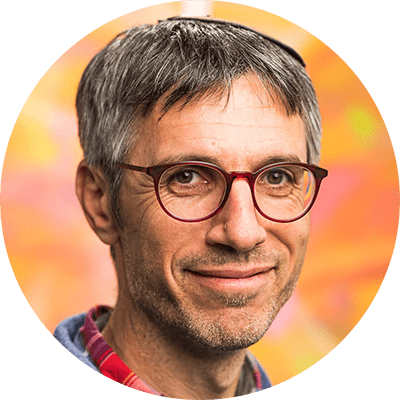Spirituality as the Gate to Belonging, and Vice Versa

Yishai Singer is the director of Makor Chaim’s Lifnai Vlifnim Educators Training Program. Rav Singer has been involved in educational instruction in fields including emotional therapy, drama therapy, group facilitation, and playback theater. He has taught high school as well as at-risk teenagers, and was awarded the 2017 President’s Outstanding Teacher Award for Special Education.
“I raise my eyes to the Heavens” (Psalms 121). We raise our eyes upwards and strive to feel closeness and connection to an infinite, hidden source. We long to hear a clear voice calling our name, confirming for us that our words arrived, traversing the space between Heaven and Earth.
We can feel a sense of belonging to one another in the merit of our shared search for God. The searching movement brings us together, we know how to seek one another, and we know how to seek the way. We know how to walk together to great lengths, even as God hides. The search for the spirit creates a language we can share together with our fellow seekers on this path—it holds a common language that includes words of closeness and distance, yearning and longing… to meet the Eternal. Our shared gazes turn upwards, and by virtue of this, our connection is formed. The aspiration to get closer to the spirit, together with a language that speaks of this path, binds us and creates a sense of belonging—within our family and in our broader community as well. In a world of vast loneliness and distance, alienation, and avoidance, we have a common path that includes aspiration and language, and we have knowledge and faith that we can walk together even if a fog surrounds us, for from within it is the voice that will speak to us, together.
Rebbe Nachman of Breslov says, “When a person has a heart, place has no relevance whatsoever.” When a person has a living, pulsing heart, he is not dependent on the physical place he finds himself. He can decide to what he chooses to be connected—to the physical place where he is, or to his heart, and through it, to create belonging.
Aspiration, Direction, and Intention
Several months ago, I visited a school whose Bet Midrash was on the building’s top floor, and from the windows, there was a wonderful and inspiring view. It was morning, the sky was blue, and the horizon was clear, making the view particularly breathtaking. I was among the first to arrive to pray, and intuitively, I positioned myself facing the view. Students began to trickle in, and I noticed they all faced the opposite direction, with their backs to the vista. I turned to join them, to face the same direction they were facing. This moment of joining my fellow worshipers to face Jerusalem led me to think of Jews all over the world who turn to face a common direction, each one from his own place. No matter the view from the window, the direction of our prayer is uniform. Metaphorically, you can imagine threads emerging from many places, all eventually reaching the same destination.
This unified turning from differing directions towards the same place creates a feeling of belonging to something bigger than I, an individual. At this moment, I am part of a wide and inclusive picture, all facing the same place. I am part of an enormous community, all oriented to Hamakom (a rabbinical reference to God), the Place. The Place of the world.
Language
As the students began to pray, one of the teachers stopped and announced, “Please turn to page 43.” The students turned to that page, and the prayer continued. A few minutes later the teacher again announced, “Everyone, turn to page 55,” and the prayer continued as the students turned to that page. These kinds of instructions happen in many synagogues and schools as part of the prayer service, helping the congregation to jointly reach the same place in the text so that they say the words of the prayer together, even if the interpretation and meaning of the words may not be clear—due to the difference between the language the worshipers speak and the language of the text or to the broad range of possible interpretations. The desire of many worshipers to persevere and use the original language of prayer, even while lacking literal understanding of the text or the meaning of the words they are saying, expresses their desire to belong to a community and to feel part of a story greater than their individual selves.
The use of these words functions as a kind of secret code, expressing their desire to be part of a chain of generations. The very act of saying the words is significant as they allow worshipers to feel a part of and to find their place in a story bigger than themselves through the use of the same text recited through the ages.
The Heavens and the Earth
One of the challenges in writing and speaking about spirituality stems from the fact that it is elusive, something felt one moment, yet gone the next. It is beyond words. It can be explained, but it must be experienced in order to actually know what is being described. We can say many words about it, but the experience of it clarifies much more than words ever can.
Similarly, when we are interested in educating our students about spirituality, when we seek to give them the understanding that a hidden world exists beyond that which we can see and to guide them as they open a window to a world in which there is faith and where they belong to a story greater than themselves, we are aided by creating experiences that go beyond our verbal explanations.
The educational path to spiritual development begins with the preparation of a stable ground on which the spiritual connection is built. In the classroom, this happens by creating a sense of belonging. The stronger and more grounded such spiritual experiences are, the higher we can rise and nurture a belonging to the spirit as well. The relationship between a person and a friend can help form a basis for the connection between a person and God. A student’s sense of belonging with his classmates, his family, and his community form the fertile ground on which a sense of belonging can grow between the individual and the Divine.
The feeling of belonging that can be distinctly felt when we are part of a group of students, friends, or colleagues is the opening to the creation of a sense of spiritual belonging. In the Lifnai V’Lifnim program, which guides the development and training of teachers as well as the development of an overall school culture, we combine social, emotional, and spiritual learning based on the concept that there is a connection and a link between the various fields. The program combines practical tools for guiding teams of educators and groups of students along with educational content dealing with spirit, study, and inner work.
Spiritual connection and a sense of spiritual belonging are built upon the interpersonal human connections created in a school culture that nourishes them. Educators find this approach offers them the possibility of engaging in a process of personal and spiritual development as they lead their students in a parallel process of their own personal and spiritual growth. This process takes place in a group setting, allowing the teacher a sense of safety and a feeling of belonging to a wider group of teachers participating in the process. When the ground is stable for teachers and they feel a sense of belonging to a group within which they can be in a process of growth and spiritual development, then they can lead their students on this path. They receive the tools to guide groups of students, creating a space where every student feels they belong to the group and can thereby learn and even increase the feeling of belonging to the spirit. A closeness to their fellow humans leads to a closeness to God.
Reflected Light
Throughout this essay we’ve seen the interrelationship between spirituality and belonging: At times it is spirituality that creates a sense of belonging to the nation, community, and family, and at times it is the sense of belonging between people that supports the aspiration and the possibility of being in a spiritual process. These interrelationships emphasize the mutuality that exists between these connections. As you near the end of this essay, pause your reading for a moment, lean back in your chair, take a deep breath, and allow yourself to think about and internalize what you’ve read. Ask yourself: “To whom or what do I feel I belong? Would I like to belong to more people, places, or things? What do I feel belongs to me?”
A Compass
We live in a time of tension, distance, loneliness, and fear of closeness. I find the pursuit of spirituality to be a source of power that can increase our sense of belonging, a compass to remind us of the path: a path we can always return to, deepen, learn more about, get closer to, and be reminded that this is the bedrock from which everything grows.
Belonging to a path that is connected to the spirit gives me hope.



Yishai Singer is the director of Makor Chaim’s Lifnai V’Lifnim Educators Training Program. Rav Singer has been involved in educational instruction in fields including emotional therapy, drama therapy, group facilitation, and playback theater. He has taught high school as well as at-risk teenagers, and was awarded the 2017 President’s Outstanding Teacher Award for Special Education.
Reach 10,000 Jewish educational professionals. Advertise in the upcoming issue of Jewish Educational Leadership.





Fantastic! Both inspirational and deeply innovative. thank you